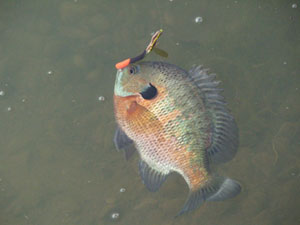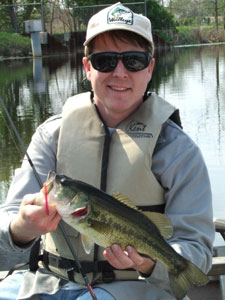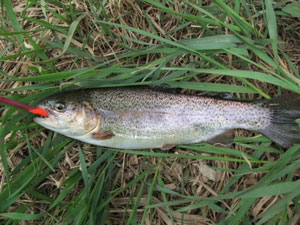The Bluegill Anise Worm®
Not Just for Bluegills

The scaled-down 2 5/8" Anise Worm® known as the Bluegill Worm may be one of the most versatile pre-rigged plastic worms you ever fish. Although it's called the Bluegill Worm, you may well call it a bass worm, trout worm, sunfish worm, etc. etc. When you throw the Bluegill Worm, you not only have a shot at some bull 'gills, but many other gamefish as well. Infused with real Anise oil scent, the Bluegill Worm is light enough to be used with a flyrod and heavy enough to be cast a good distance with light spinning gear. A key to success is choosing colors and presentation to suit the conditions and the desired species.
Its namesake
The bluegill: the scrappy little fighter that inhabits thousands of North American lakes. The first fish of many wide-eyed children, anglers in the making. Some of us wide-eyed adults still get excited about a big bluegill bending over a flimsy fishing rod! And sometimes that begins with a big bluegill pouncing on a Bluegill Anise Worm®.
Bluegills and Sunfish and Crappies, oh my!
In the early spring, right after ice out, bluegill, sunfish, and crappies move into shallow bays where the water warms quickly. Try casting the Bluegill Worm and working it slowly from 1 to 4 feet down with an occasional pause on the retrieve. Or fish it from 1 to 3 feet under a small float, keeping the bait moving ever so slowly toward you by reeling. Impart additional action to the worm by jiggling the rod tip during the slow retrieve.
Late in the spring these panfish move into shallow flats near weeds or along shorelines for food, and then later, spawning habitat. By now the fish are more aggressive than in the cooler weather, and they are prepared to defend their territory. The Bluegill Worm can be retrieved a little faster through the shallows at this time of year. Be prepared for an immediate hookset after a strike. Try using a cane pole to drop the worm into a hole in the lily pads.

In midsummer, panfish can always be found in the shallows. But many of the larger fish have moved out into deeper water, congregating on outside edges of weedlines and around structure on deep flats. This calls for adding split shot above the Bluegill Worm to get it down deeper. Fish it with a lift-drop retrieve or still fish it under a slip bobber. Use similar presentations on into the fall. Light or Ultralight spinning tackle will make fighting the fish all the more enjoyable. And the Bluegill Worm is small enough you can even use it ice fishing in the winter.
Perchy bites
Anyone who has ever used Lindy rigs for walleyes should know about perchy bites. When using a live nightcrawler, the yellow perch keep pecking at it, taking little bits off at a time, starting at the tail and working their way forward, stealing most of your bait. With the Bluegill Worm's tail hook, you have the upper hand on the perch. Try the black color, which resembles a small leech, or the natural nightcrawler color. Or cast a brighter color such as white or yellow into shallow vegetation where perch are holding. Try adding a removable spinner blade to the leader for a little flash.

Bass
Big baits, big fish.right? Not always. If you're throwing big baits and not catching any bass, try going with something smaller. The Bluegill Anise Worm® is a great finesse bait for finicky bass that want a smaller offering. For bass cruising the shallows, try a slow retrieve or short sweeps of the rod tip to produce an erratic motion. Or use a small bullet weight or split shot to explore deeper weedlines, rockpiles, and points
Trout
If you've spent much time fishing for trout or salmon, you know that many trout lures come in bright colors such as orange, pink, chartreuse, and green. The Bluegill Anise Worm® fits the bill for the trout angler as well, with colors like bubblegum, chartreuse, catalpa, and light purple firetail. The firetails are a lot of fun to use when trout fishing because the trout seem to key in on the bright orange tail section of the worm. And where the bright orange is, there is also a hook waiting for them. Take a few Bluegill Worms with you to your favorite trout stream and give them a try.
